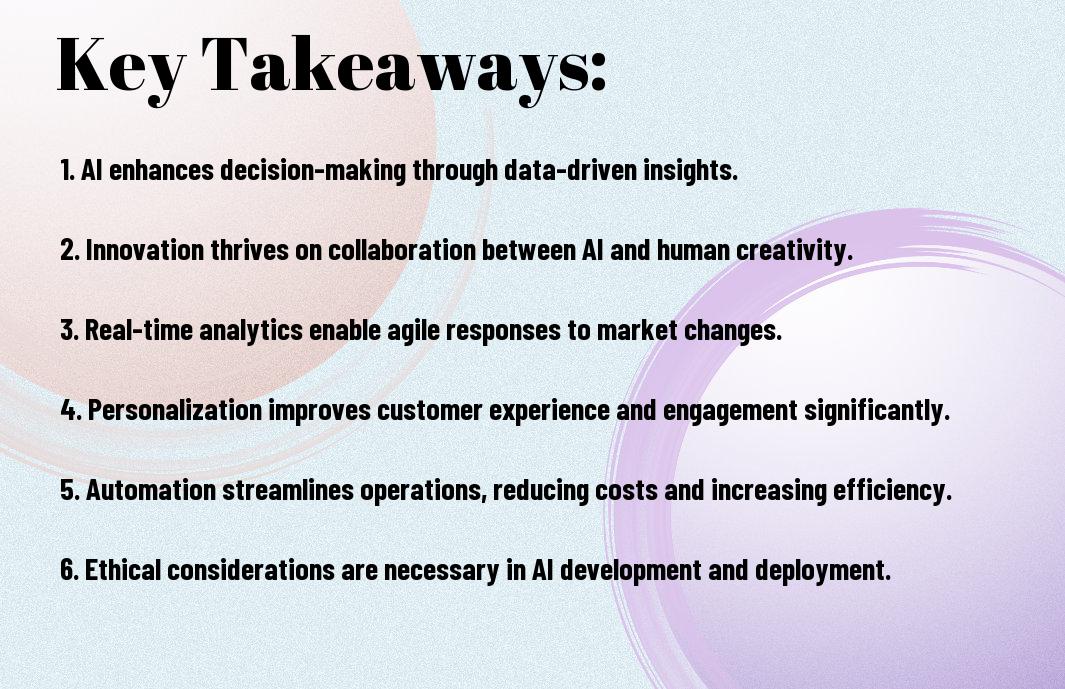Key Takeaways:
- AI-driven business innovation is transforming industries by leveraging machine learning, natural language processing, and data analytics to drive growth, improve efficiency, and enhance customer experiences.
- Companies that successfully integrate AI into their operations can gain a competitive edge by automating processes, predicting market trends, and making data-driven decisions.
- Effective AI adoption requires a strategic approach, including identifying areas where AI can add value, developing a robust data infrastructure, and fostering a culture of innovation and experimentation.
- AI-driven innovation can also raise important ethical and societal considerations, such as job displacement, bias in decision-making, and data privacy, which must be carefully managed and addressed.
- By embracing AI-driven business innovation, organizations can unlock new opportunities for revenue growth, improved customer engagement, and sustainable competitive advantage in a rapidly changing business landscape.


The Foundation of AI in Modern Business
For your business to thrive in today’s competitive landscape, understanding the role of Artificial Intelligence (AI) is vital. You need to grasp how AI transforms operations, enhances customer experience, and drives innovation.
Core Technologies Driving the Revolution
Any analysis of AI’s impact on business must consider the core technologies involved, such as machine learning and natural language processing, which enable your systems to learn from data and interact with customers more effectively.
The Cognitive Leap: From Data to Intelligence
For you to harness the full potential of AI, it’s vital to understand the transition from mere data collection to actionable intelligence, which allows your business to make informed decisions and stay ahead of the competition.
Due to the complexity of this transition, you will need to invest in developing a robust data strategy that not only collects and processes large volumes of data but also interprets it in a way that drives meaningful business outcomes, enabling you to leverage AI’s capabilities to their fullest extent and propel your business forward in an increasingly digital world.
Disruption Vectors Across Industries
Even as you explore the potential of AI-driven business innovation, you’ll notice that various sectors are being transformed in unique ways, leading to new opportunities and challenges that you must navigate to stay ahead.
Traditional Sectors Reimagined
Above all, you’ll find that traditional industries like healthcare, finance, and education are being redefined by AI, forcing you to rethink your approach and adapt to the changing landscape in order to remain competitive.
Emerging Business Models
Similar to other areas, sectors like transportation and energy are giving rise to innovative business models that you can leverage to drive growth and improve efficiency, making it imperative for you to understand these developments.
Hence, as you research deeper into emerging business models, you’ll discover that AI is enabling new forms of collaboration, product development, and customer engagement, allowing you to create novel solutions that meet evolving customer needs and stay ahead of the curve in your industry.
The Economics of AI Implementation
Many businesses are turning to AI to drive innovation, but you need to consider the economic implications. You must weigh the costs and benefits of AI implementation to make informed decisions about your business strategy.
Cost-Benefit Analysis Framework
Between the potential benefits and drawbacks of AI, you will find a delicate balance. You should develop a framework to evaluate the costs and benefits of AI implementation, considering factors such as investment, return on investment, and potential risks.
Resource Allocation Strategies
After allocating resources for AI implementation, you will need to prioritize your investments. You should focus on the areas that will drive the most value for your business, such as talent acquisition, infrastructure development, and process optimization.
At this stage, you will need to consider your resource allocation strategies in more detail. You should assess your current resources, identify gaps, and develop a plan to allocate your resources effectively, ensuring that you have the right talent, technology, and infrastructure to support your AI-driven innovation strategy, and that you are using your resources in a way that maximizes your return on investment.
Human-Machine Collaboration Paradigms
Unlike traditional business models, AI-driven innovation relies on the synergy between humans and machines, enabling you to leverage the strengths of both to drive growth and success.
Workforce Evolution
With the advent of AI, you will witness a significant shift in your workforce dynamics, as machines take over routine tasks, freeing your employees to focus on high-value tasks that require creativity and problem-solving skills.
Skill Transition Management
Paralleling the rise of AI, you will need to manage the transition of skills within your organization, ensuring that your employees are equipped to work effectively with machines and leverage their capabilities to drive innovation.
Consequently, as you commence on this journey, you will need to invest in retraining and upskilling your workforce, enabling them to develop the skills required to collaborate with AI systems, such as data analysis, interpretation, and decision-making, ultimately driving your business forward.
Ethical Considerations and Governance
After implementing AI-driven innovations, you must consider the ethical implications of your business practices. You need to ensure that your AI systems are transparent, fair, and accountable to maintain trust with your customers and stakeholders.
Responsible AI Development
Responsibly, you should prioritize the development of AI systems that align with your organization’s values and principles. You should consider the potential risks and benefits of AI and develop strategies to mitigate any negative consequences.
Regulatory Horizons
By understanding the regulatory landscape, you can navigate the complex rules and guidelines surrounding AI development. You should stay informed about emerging regulations and standards to ensure your AI systems comply with legal requirements.
Consequently, as you explore the regulatory horizons, you will discover that governments and organizations are establishing guidelines to ensure AI is developed and used responsibly. You can expect to see more emphasis on transparency, explainability, and accountability in AI decision-making processes, which will impact your business innovation strategies and require you to adapt to the evolving regulatory environment.
Strategic Implementation Roadmap
Keep in mind that a well-structured roadmap is crucial for successful AI-driven business innovation, allowing you to navigate the complexities of implementation and maximize your returns on investment.
Assessment and Planning Methodologies
By leveraging established frameworks and tools, you can effectively assess your organization’s readiness for AI adoption and develop a tailored plan that addresses your unique needs and goals.
Integration and Scaling Approaches
For seamless integration, you should focus on developing a phased approach that aligns with your overall business strategy, enabling you to scale your AI initiatives efficiently and effectively.
Hence, as you research into integration and scaling, you will need to consider factors such as data management, talent acquisition, and change management, ensuring that your AI solutions are fully aligned with your organization’s objectives and that you have the necessary resources to support long-term growth and success.
Summing up
Hence, as you examine into the world of AI-driven business innovation, you will discover new opportunities to transform your organization. You will learn to leverage AI to drive growth, improve efficiency, and enhance your decision-making capabilities. By embracing AI, you can unlock new revenue streams, optimize your operations, and stay ahead of the competition, ultimately taking your business to the next level and achieving your goals.
FAQ
Q: What is AI-Driven Business Innovation and how is it transforming industries?
A: AI-Driven Business Innovation refers to the integration of artificial intelligence technologies into business operations to drive innovation, improve efficiency, and enhance decision-making. This transformation is happening across various sectors, including healthcare, finance, and retail, where AI is being used to analyze vast amounts of data, automate processes, and predict customer behavior. By leveraging AI, businesses can unlock new revenue streams, improve customer experiences, and gain a competitive edge in the market.
Q: How can businesses harness the power of AI to drive innovation and stay ahead of the competition?
A: To harness the power of AI, businesses should start by identifying areas where AI can add the most value, such as improving operational efficiency, enhancing customer engagement, or developing new products and services. They should then invest in AI technologies, such as machine learning and natural language processing, and develop a skilled workforce to implement and manage these technologies. Additionally, businesses should foster a culture of innovation, encourage experimentation, and collaborate with AI experts and startups to stay up-to-date with the latest advancements in the field.
Q: What are the potential risks and challenges associated with implementing AI-Driven Business Innovation, and how can they be mitigated?
A: The implementation of AI-Driven Business Innovation can pose several risks and challenges, including data privacy concerns, job displacement, and the potential for AI systems to perpetuate biases and errors. To mitigate these risks, businesses should prioritize transparency and accountability in their AI systems, ensure that they have robust data governance and security measures in place, and invest in ongoing training and education for their workforce. They should also establish clear guidelines and regulations for the development and deployment of AI, and engage with stakeholders to address concerns and build trust in AI technologies.



